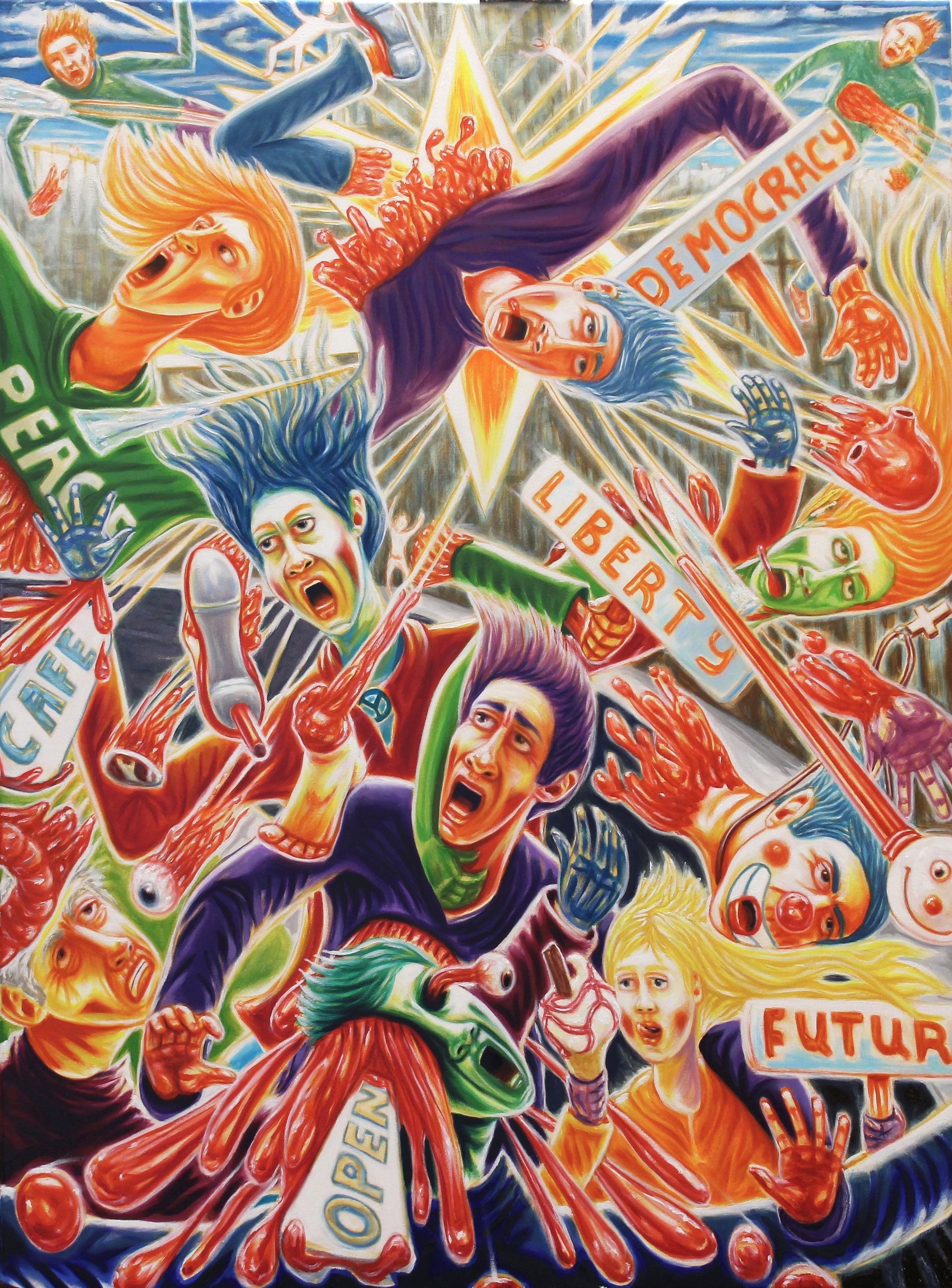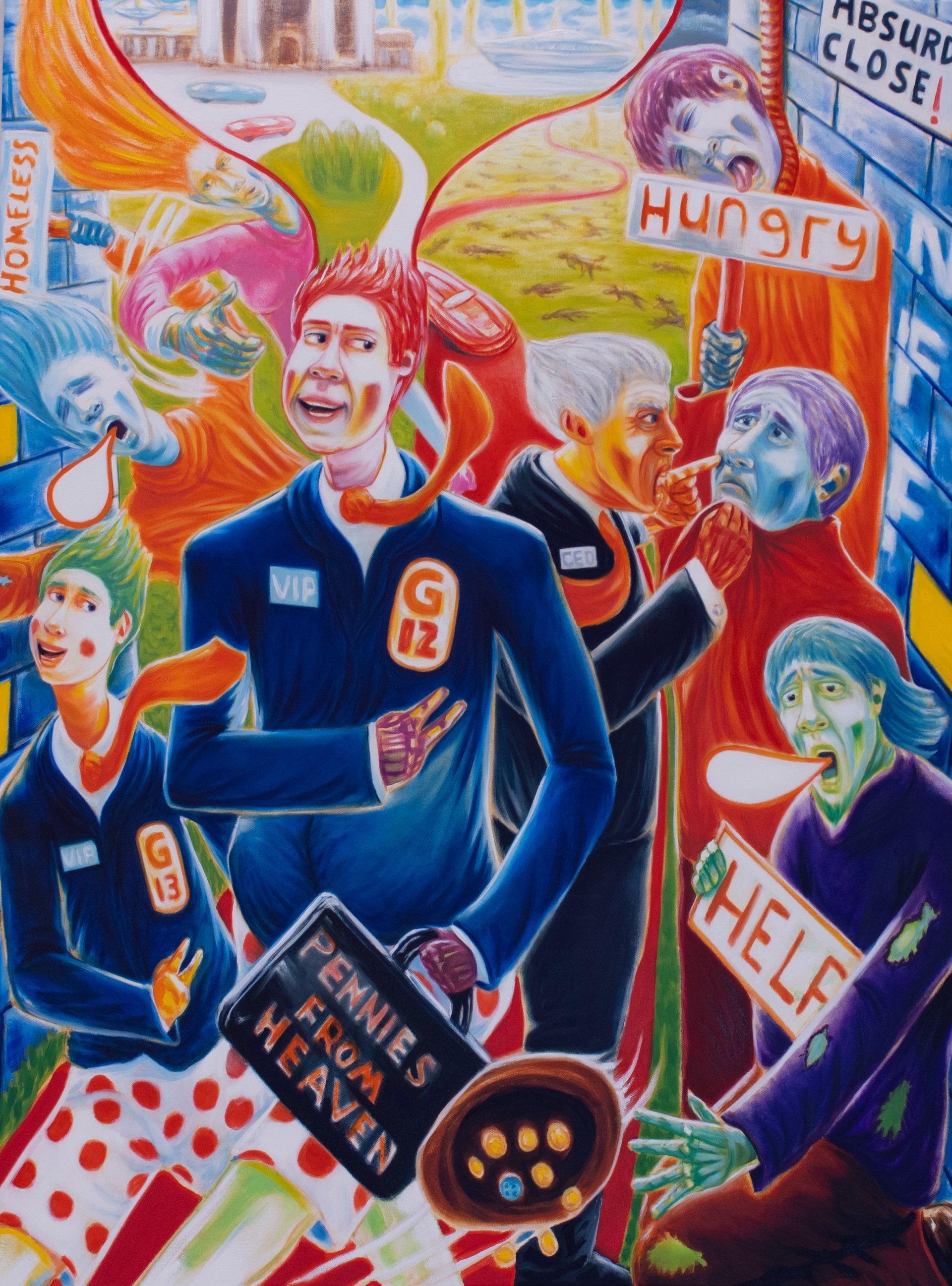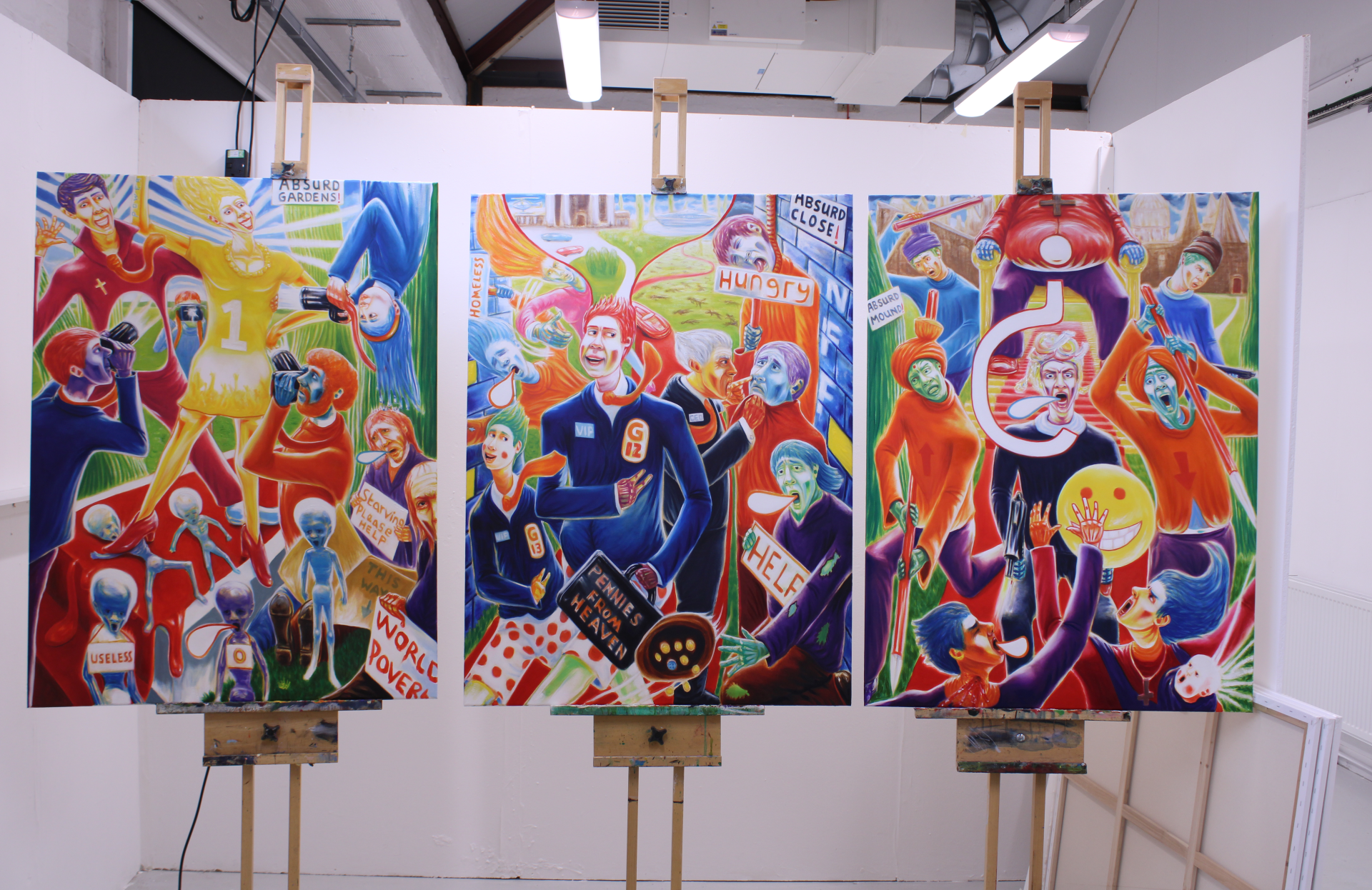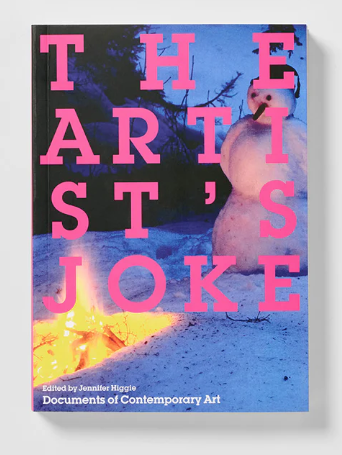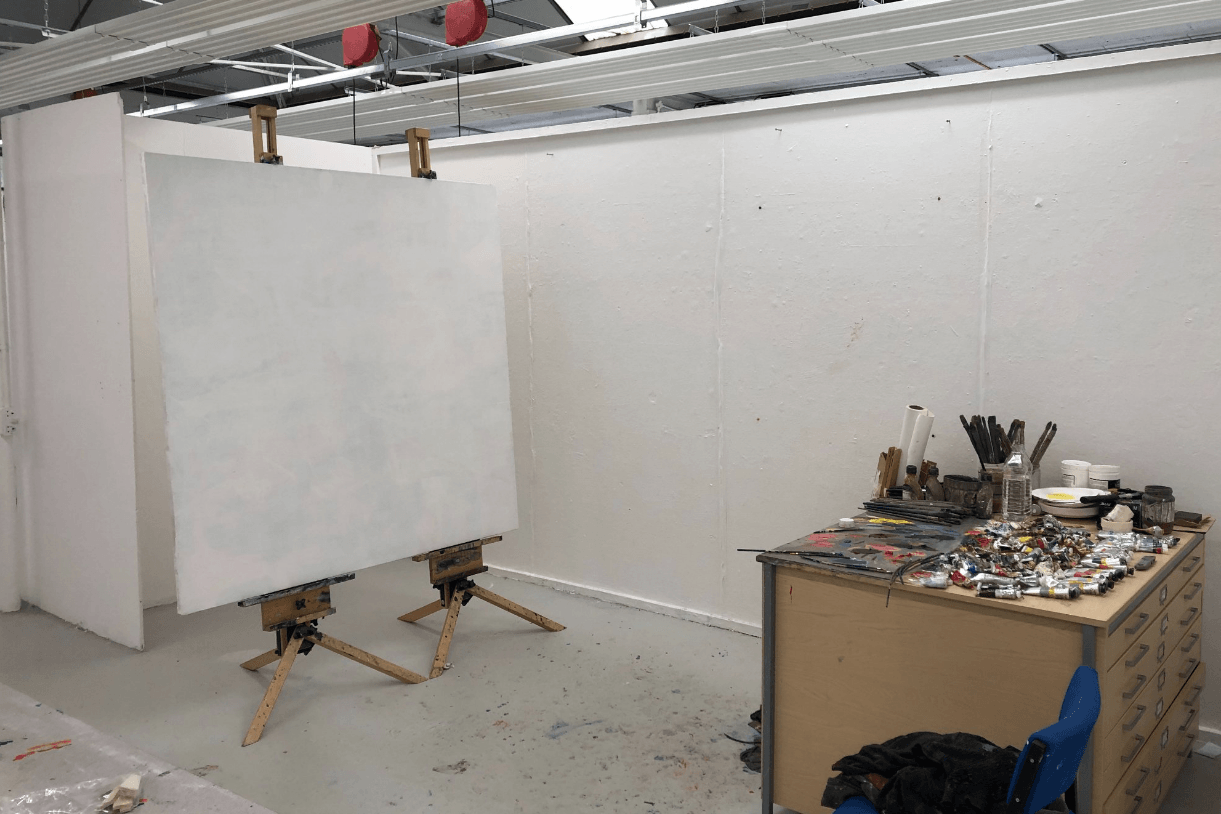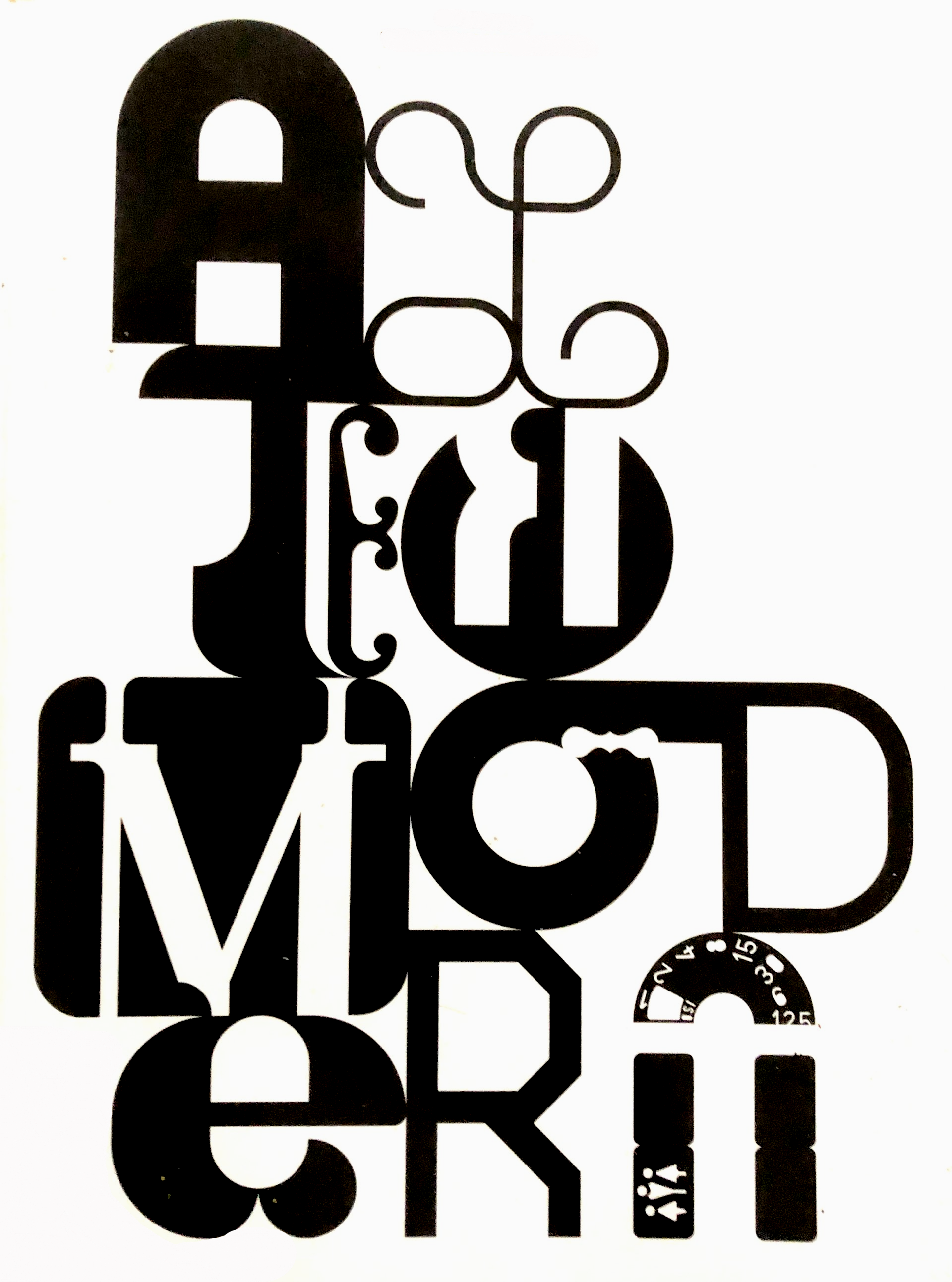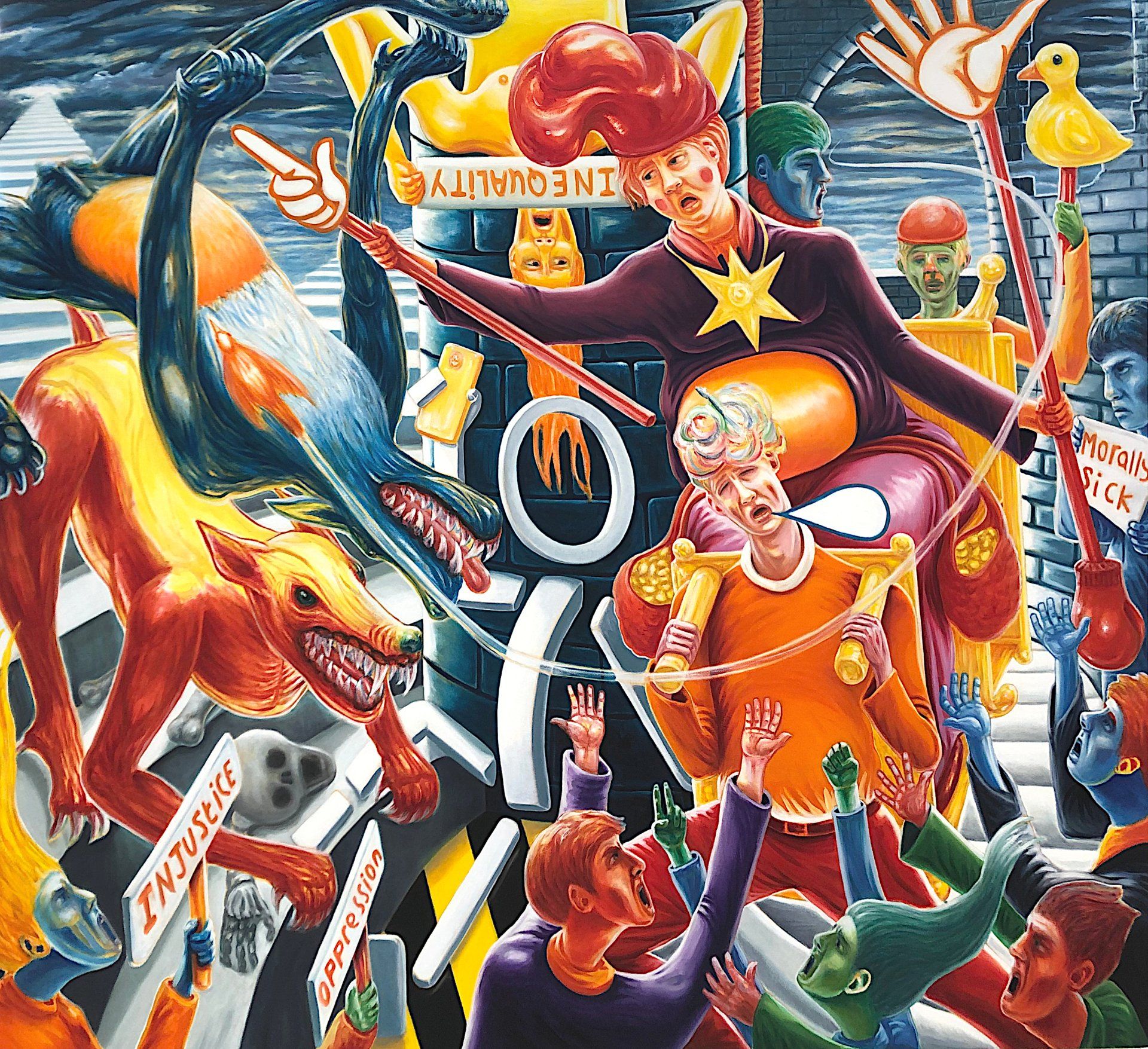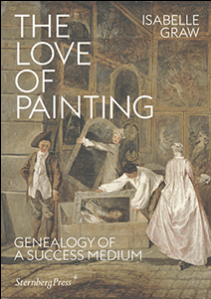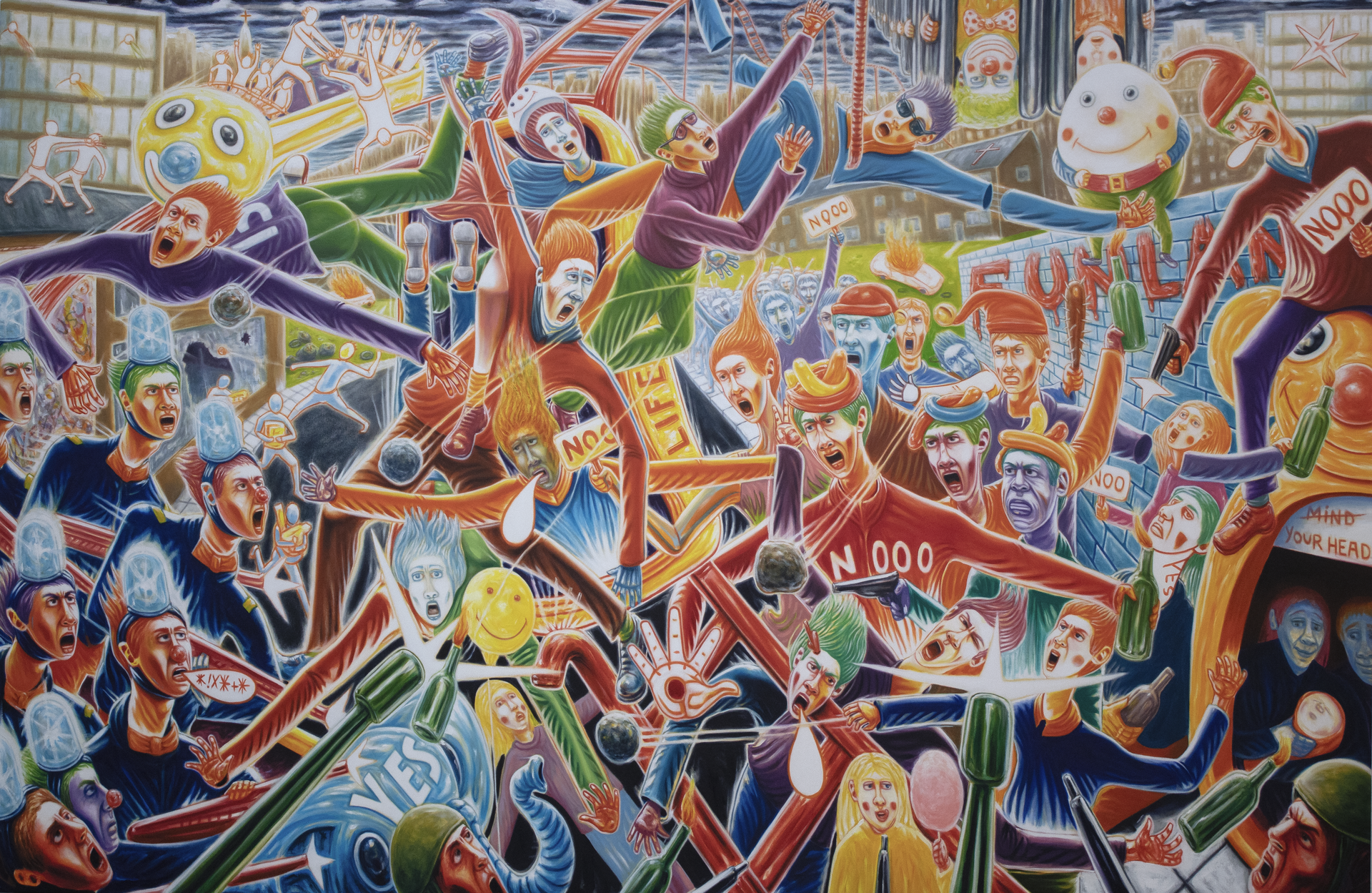
Can satirical painting be reconceptualized in relation to the social
dynamics of alter modernity, allowing for an unambiguous
articulation of accessible statements?
Abstract
Satire’s importance speaks to a wide audience through universal signs, systems, and icons. A key facet of my research is to examine the changing ways in which these signs communicate within changing multicultural and historical epochs.
Visual Satire has been understood historically as both a political cartoon, and fine art painting. Hogarth is remembered as the forerunner of satirical caricatures and moral paintings, a genre which would later develop into cartoons. An example of Hogarth’s painting is A Rake's Progress, which took a satirical look at the government and social scene of the day, highlighting the worst of English culture.
An early exponent of satire was Francisco Goya, who criticized his society through his Black Painting’s series. The war between France and Spain seriously impacted Goya who painted a satirical view of the third of May atrocities. The works described and addressed the social wrongs within a unified social field, particular to his own time.
The relationality of alter modernity to my project represents the coalescing of postmodern fragmentation into an arena of conflicted certainties. Alter modernism represents a reformulation of the social field within a creolization, archipelago context. Alter modernism advocates for universal certainties and truths. Contemporary satire operates within the epoch of alter modernity which places transcultural universal tensions into conventional definitions of satire, and it is uses. These tensions exist within postmodernism, which is born of colonial west centricities. Postmodernism undermines universal certainties and truths, and problematizes allegory and the auspices of authorial practice, negating the presence of multiculturalism and universally understood sign systems. The relationality of alter modernity conflicts with colonial west doctrines. Satire needs to be rethought in a world of hardened attitudes and threatened identities, which are attempting to navigate a world in perma crisis.
A characteristic used to identify Postmodern painting was a distinct break between fine art and popular culture. An example of colonial west postmodern painting is by the American Peter Saul, variously described as a pop artist and a satirist, whose work is entrenched in American culture.
Painting is a means of addressing this world in opposition and re-introducing a sense of universal value through the specificity of the medium. I aim to understand satirical painting’s role as a universal conduit for relationality, within the theoretical framework of alter modernism. My research will question painting’s relation to the receiver of the work through individual envirobiopsychosociospiritual factors, that may influence aesthetic image judgement. My research has acknowledged that the common experience of painting has an affect through emotive response. Satirical painting positioned as facilitator through exhibitions act as a conduit for the inclusion of the respondents' voices as lived experiences of perma crisis. My research will be qualified through a series of workshops, lectures, and seminars to share information and garner critical feedback to test audience response.
Original contribution
The specificity of painting’s debate is the perimeter for my engagement in painting within the traitorous waters of alter modernity. Satirical painting is currently under explored in this debate, despite Kippenberger’s satirical focus of foundational reference within it. I am contributing a renewed engagement with satire in the context of debates around alter modernity and the rethinking of painting’s specifity. My project seeks to address the scarcity of satire within the specifity of contemporary painting and the framework of curational practice. Within the ecology of the art world, I extend the scope of renewed engagement with painting’s specificity within the 21st Century and link this position to relationality under the auspices of alter modernity.
Research Aims
1.I will seek to engage unique and universally applicable address of painting within the context of satire. I aim to understand the extent to which satirical painting affords a universal meter for relationality, through the auspices of alter modernism.
2. My project seeks to show auto-ethnographic studio practice and contested audience responses as objects of enquiry. The exhibition context will inform these aspects of my investigation
Research sub-Questions
1. How can individual studio practice support an auto-ethnographic investigation of Perma crisis to produce a series of satirical paintings?
2. Can such paintings address audiences in a universal register, whilst acknowledging the relational dynamics of alter modernity?
3. What modes of presentation and audience participation can vocalize differing responses to my paintings and how can these voices be integrated into exhibitions of my work?
Literature review
The design of the content structure; (provisional table of contents) Satire, relationality, alter modernity and painting, presents a theoretical underpinning and practice methodology, to inform, validate, and add credibility to my research argument. Painting has a universal appeal; satire can be a vehicle for respondent relationality. This context assists me in rationalizing the development of the making and showing dimensions of my practice.
Satire
Satire has been used extensively throughout history as a tool for critique and social commentary. Contemporary notions of satire both academically and within the normalized constructs of the populace have become an ambiguous overarching umbrella term applied to a critique of political and sociocultural systems, humor, parody, sarcasm, and irony, through a wide range of modern media. An example of historic satirical painting is Pablo Picasso’s Guernica. Picasso painted Guernica as a reaction to the 1937 bombing of the Basque Country, Spain, by the fascist Spanish army, highlighting the pain and horrors of war. Satire was not Picassos’ intention; however, my research has indicated that the work does fall within the remits of ‘silent’ satire in the form of a critique (see: Declerc contemporary definition of satire; ‘Critique and entertainment’). The work shows how satire has assumed the wrongs it addresses which can be identified within coherent social contexts, such as the wrongness of individuals, institutions, systems, and shared values. The relationality of contemporary satire references the Latin origin ‘medley or stew’ which understands something original of the concept of satire. Contemporary satire contends with this fragmented social field of oppositional ideologies; however, the original ‘medley or stew’ definition is recovered within this current context.
My literature review has enabled a broad definition of Satire. The historical theoretical discourse of satire is comprehensive, especially within the frameworks of literature, and theatre. Conden stipulates; “A putative origin within Greek satyr plays, that accompanied early tragedy then developed into Attic comedy, was questioned by Julius Caesar Scaliger (1484–1558) and seemingly disproved by Isaac Casaubon (1559–1614) who effectively supported the claim by the Roman rhetorician Quintilian (AD 35–c.100), that satire was a Roman invention (Casaubon, 1605; Quintilian, 1920–1922: 10.1.93). Casaubon argued that the word satire derived from the Latin, satura, medley or stew; and something of this etymology survived in English with “satira” being a broad platter (Bailey 1735; Facciolatus and Forcellinus 1828) Casaubon’s case has largely been accepted from John Dryden to the twentieth century” (Dryden,1693; Highet, 1962). (Conden, 2012. Pg. 356-377)
Satire today has great viability and impetus within a society that is seemingly estranged from itself. In times of high insecurity, anger at social inequalities, and the general public's apparent disillusionment of the power elite, have enabled a revived focus on humor and satire, expressing public opinion, and appeasing anger and frustration. A collective example of the contemporary use of satire was illustrated through the Black Mirror, Art as Social Satire exhibition, presented at the Saatchi Gallery London (October 2018) It aimed to show the importance of art when the truth is stranger than fiction, in relation to our uncertain times. The exhibition highlighted works by 26 contemporary artists working within differing media, exploring the role of art in social satire.
Relationality
My research purpose is to understand how truth and relationality correspond to the specifics of painting as satire, bringing due priority to subjugated voices. My research seeks to understand how relationality corresponds to individual and collective truths. Relationality can be seen as a universal construct, Crouch addresses relationality’s universality; “Universal signs are ingested both through diverse cultures and pertinent to an individual’s own culture. The cultural Design- The societal substrate is formed by intersubjectivity, the collective elaboration of meaning.” (Crouch, 2020. p.122). Rancière is addressing the constitution of ethics within relationality; Rancière states that Cultural equality is a universal right. “Rancière’s model of equality has had significant impact, he has enabled voices from those in a minority to emerge with confidence in different spaces, human beings constantly take part in several worlds.” (Rancière 2009 cited in Matthews, 2022. pp.749-763) International culture’s, differ from colonial west doctrines. Rancière’s model implies that all views should be considered as making an equal claim and not be subjugated to structures of consensus. Rancière’s ethical view corresponds to transcultural universality through an acknowledgement of an entire world collective view. Transculturalism recognizes cultural differences, and the specifics of the culturally defined self. Transculturalism extends through all cultures, combining elements of multiple cultures. Lewis outlines; “Transculturalism is distinguished by its emphasis on the problematics of contemporary cultures, in terms of relationships, meaning making, and power formation. Transculturalism is also interested in dissonance, tension, and instability.” (Lewis, 2002 pp. 749-763) encompassed by Alter modernism's transcultural universality.
My research draws upon Althusser’s ISA’s thus accounting for its ideological development. Althusser differentiates the particularity of identities from the universality of primal responses, both equality (Rancière-ethics) and relationality, (Althusser -Crouch). Althusser acknowledges that learned behavior is pertinent to truth and relationality. It is universally accepted that human beings are normalized and socialized through societal systems. Althusser’s universal subjugation by authority claim recognizes the diversity of ideological development within different subjectivities. Within Althusser's paper ‘Ideology and Ideological State Apparatuses’ (ISA’s) Althusser gives an account of ideological State apparatuses’ (ISAs): “The bourgeois institutions, notably family, education, and religion, that shape the subject to secure its submission to the rules of established order “. (Birdwell, 2017 p316) However, we must also consider the Holism of every unique human being as a multitude of envirobiopyschosociospiritual elements. (Lawler, 2001) Universal human coping mechanisms encompass both a biological and cognitive response. An example would be when watching a horror film (entertainment) just at the point when a particularly harrowing/gory moment happens, instead of a horrified recoil, a deep-seated laugh occurs. This is both a biological and cognitive response to a stressor. Fight or flight is an innate, universal coping mechanism. “A fight response; Arousal-endorphins-elation-counteraction-humor (laughter); ‘The ‘fight or flight’ response, or ‘acute stress response,’ If a stimulus is perceived as a threat, an intense and prolonged discharge of the autonomic nervous system (ANS), followed by attempts to flee, and, if not successful, by attempts to fight.” (Schauer, M. Elbert, T. 2010 pp.109–127)
Alter modernity
Alter modernity is a critical response to postmodernism. My research has found postmodernism to be a limited construct. Postmodern contingency fails to account for the emergence of transculturalism. Conversely, alter modernism accounts for the dynamics of transculturalism by offering a broader worldly view, that understands individuality, and the importance of allegory to individuals of diverse cultures. Alter modernisms transcultural universality offers a broader spectrum for satire as opposed to a Colonial west centric, politically secular, one culture view of postmodernism. Postmodernism can be described as a set of critical, strategic, and rhetorical practices employing concepts such as difference, repetition, the trace, the simulacrum, and hyperreality to destabilize other concepts such as presence, identity, historical progress, epistemic certainty, and the univocity of meaning. (Aylesworth, G. 2015 online) Postmodernism negates the concepts of authorial practice, and the allegorical narrative. Owens postulates; “Postmodernism neither suspends the referent but works instead to problematize the activity, when the postmodernist work speaks of itself, it is no longer to proclaim its autonomy, its self-sufficiency, its transcendence; rather, it is to narrate its own contingency, insufficiency, lack of transcendence” (Owens. 1980. p 58-80) Kippenberger and Atkinson offer an alternative to postmodernism. Kippenberger and Atkinson (Fig 5-6) undermine Owens’ account of postmodernism as the only way of accounting for art of the 1980s. Both artists anticipated the emergence of a unique way of working with the narrative, and analogy within painting, thus anticipating alter modernity. These ideas are informing and directing both my research and practice.
My research seeks to understand how the lens of alter modernity casts the world. Alter modern's satirical relevance is founded upon what Bourriaud describes as nomadism (independent/self-determined) “Nomadism advances a critical strategy; its creative mobility challenges the homogenizing aspects of capitalism". (Bourriaud, N.1998. p 224) Nicholas Bourriaud augmented the term Alter modernism and curated The Tate Britain Tate Triennial in 2009. Presented a collective discussion around the premise that postmodernism was coming to an end, and that we are experiencing the emergence of a global alter modernity. "Alter modernism offers a multicultural universality defined by creolization and polyglot expansion. Contemporary culture can no longer be seen as a single totality, but as an interrelated network, described as an archipelago. Post modernism is dead. A new modernity is emerging, reconfigured to an age of globalization, understood in its economic, political and cultural aspects: an alter modern culture." (Bourriaud, N.1998. p 224) The Tate triennial exhibition was curated to involve the artists that Bourriaud recognized as fulfilling the new alter modern agenda. ‘The art is characterized by artists cross border, cross cultural negotiation; a new real and virtual mobility the surfing of different disciplines, and the use of fiction as an expression of autonomy.’ (Bourriaud, N.1998. p 225)
Several of the artists that exhibited fulfilled a representational painting perspective. Notably, Navin Rawanchaikul, a Thai artist whose ancestral roots are the Hindu-Punjabi communities of present-day Pakistan. Bourriaud wrote in a ‘letter to the editor', in Navin's Sala 2008; “This generosity of iconography: Perhaps we have got too used to a dry spell of thought, instead of highlighting this tradition as such, like those bad artists who have no other ambition than to conform to what the market demands of them.” (Bourriaud, N. 2009. p 227)
Painting
My project frames painting practice as fitting in relation to our erratic times as it intrinsically holds within it, abundant possibilities for examining feelings of change and variance, expressively, materially, and idiomatically. My research has quantified a broad spectrum of the history of painting and its contemporary relevance. Painting has persisted despite innumerable efforts to negate it. Most explicitly, from the post-war period onward, painting has been fractured, deconstructed, and reconstructed again. Illustrated by the retreat from medium specificity, in the 1970’s, alongside the hegemonic force of Greenbergian formalism and the expanded field. Clement Greenberg's modernist criticism attempted to limit painting to its formal elements, which led to the rejection of painting in minimalist and conceptual art movements. David Joselit has stated; "Painting was killed by revolutions, it was killed by commodities; it was killed by flatness, and it was killed by sheer boredom, but repeatedly it was resurrected only to die another day. This is painting’s modern tragedy: a modern form of history painting." (Joselit. D 2002) however, Graw states "What is painting if it is not based upon an intrinsic aesthetic, a pleasurable commodity? Painting operates in the realm of sensual and affective qualities.” (Graw, I. 2018. p154) Graw sustains the contradiction of sensuousness and commodity exchange as central to painting’s specificity in contrast to postmodernism. “Among the traditional distinctions shed by art after Modernism were the specifications of genres and media. This condition of ‘post-modern art’ has acquired titles such as the ‘dematerialized art object’ (Lucy Lippard); ‘Intermedia’ (Dick Higgins) and the ‘post-medium condition’ “(Rosalind Krauss. p58). The loss of this distinction between art and ‘life’ meant a corresponding loss of certainty about what the rightful object of aesthetics is (Graw, I. 2018. p154) My research makes an appeal to the implicit qualities of painting as a re-evaluation of these debates.
Painting is both reflective and reactive. (allegorical) Owens argument manifests mediation, particularly regarding allegory; “Painting is palimpsestuous, in having been reused or altered while still retaining traces of its earlier form; ‘A multilayered record, the withdrawal of the modernist arts from allegory may thus be one factor in their ever-accelerating loss” (Owens. 1980. p 58-80) Martin Kippenberger and Terry Atkinson are examples of painter's allegorical content in their move to history painting in the 1980’s Atkinson has stated; “Social Realism was Western art’s most conspicuous ideological opposite…I was seeking, that this work should mark itself out as a self-conscious attempt to break out from what I considered by 1974 as the narrowing preoccupations of Conceptualism”. (Yale Union. 2019 Article online.)
My work offers a Critique of the history of inhumanity. The absurdity and dysfunction of the human condition, and its multinational, multicultural, systems. My work draws from historical episodes, an example is the central figure pushing a cart of dead bodies, referencing the holocaust. I Utilize satirical narratives, encompassing relationality (known events) and alter modernity (cross culture episodes) My current project work can be viewed here: http://www.johnhoganartist.com
Methodology
My methodology incorporates painting, curating, and exhibiting. My literature review provides four key parameters (satire, painting, relationality and alter modernity) that will be combined within the studio and exhibition aspects of my methodology.
a. Findings
My methodology has gained favorable success thus far. I utilize satirical paintings as a conduit for consumer experience. Through exhibition testing I have understood that my work contextualizes content and readability for respondent uptake and viewpoints. My research found a receptive audience; the more an individual is directly affected by satirical life experiences, there seems to be a greater positive reaction. I also realize that my audience may have a far broader demographic. I wish to understand the changing moral and ethical reasoning of consumers in the uptake of personally challenging imagery comprehension. I have made efforts to realize a recent collaborative exhibition to collect data. Ethics approval has been accepted provisionally. I understand there may be limitations in the future regarding exhibiting some of my work. The MPhil period has enabled a passage through to PHD phase, through learning processes, one of the issues I have come to understand is that I require a more proficient way to engage effectively with audiences. The PHD phase of my project will seek to understand audience responses as objects of enquiry, through a range of exhibitions. I am interested in the differing modes of presentation and how audience participation can vocalize responses to my work, and how these voices can be integrated back into future painting exhibitions. I wish to research further through PHD phase, the relatable terms of stoicism, and Catharism in relation to audience encounter, and the mindfulness of subject proliferation. I have also considered utilizing other artists' work in differing media in conveying satire within future exhibitions, I will seek to action this collaboration within the PhD phase. My current research will be further expanded/developed to include interconnected details and structures of possible related fields.
b. Reflection
I possess a strong social conscience, and a deep concern for human rights, this, in combination with a unique lived experience, has enabled numerous painting styles to proliferate the satirical message. My practice-led research utilizes self-reflection, drawing upon my own life experiences and discursive engagements with a range of interlocuters. I position my work both within a contextual framework, and within an aesthetic paradigm. Satires codification creates a structured method representing the unique homo viator experience. I view my work as a political tool, a way of expressing my understanding of the world around me and suggesting new ways for society to evolve and adapt. My experiences recollected through painting combine with my impressions, ideas and beliefs while surveying the social context of conflicted ideologies. My paintings promote my goal of an egalitarian and just society that offers easily read and understood visual encapsulations of this vision. Paintings sufficiency has led me to think about the importance of exhibitions to facilitate a full expression of alter modernity.
Autoethnography
The Studio is the context of auto-ethnographic painting where I develop works that contextualize subjective experiences and frame them at the junctures of social relations. The auto-ethnographic and practice development specific to my project is also discussed within a series of video presentations. “Autoethnography includes the recognition of the ways personal/cultural identities, shape perception, and experience, the importance of narrative storytelling, and the crisis of representation, autoethnographic projects use selfhood, subjectivity, and personal experience to describe, interpret and represent beliefs" (Adams, T.E. Herrmann, A.F. 2020 pp. 1–8,) The transition from the studio process to exhibition and audience engagement is a manifestation of alter modernity. My methodology allows me to manifest the specificity of satire within alter modernity. Autoethnography explains my methodology in that it manifests the specificity of satire within alter modernity through painted image association (the relational codes of satire) Alter modernity encompasses transcultural universality, encompassing the relational self, that interrelates a collective understanding. An autoethnographic example of my process was when I was making a painting that inspired a realization within the studio. I realized that if my work was understood as it relates to myself, then it may be presumed to be relatable to a receptive audience. I have tested my research questions by supporting an investigation of perma crisis, by addressing audiences in a universal register, whilst acknowledging the relational dynamics of alter modernity. I have tested my methodological approach through exhibitions (Hanover project), interviews and presentations.
I have interviewed Ken Curie. The interview with a contemporary painter verified my research by offering a comprehensive view of contemporary satire. The interview informed subsequent project development by example. The interview addressed directly the four themes of my research, in that Currie outlined his reaction to contemporary painting and satire's role within the art world. In a personal email response to my own work, Currie offered praise of both my style and subject matter. I returned the compliment, citing examples of his early work as favourites. I realized his stylistic approach had evolved from a mannerist approach to realism. Here is the initial question I formulated, with his answer:
Q1. What are your views as to the relevance of representational painting within contemporary art? Would you consider your work to be mannerist in nature? If so, how does this relate to contemporary thinking, is mannerism justified?
A.1. I think my earlier work up until the mid-1990s could be described as “mannered”, with elongations and distortions of the figure, and slightly caricatured heads. I then became disaffected by this work and started to work much more from observational notes and photographic references. This seemed to rid the later work of that mannerist quality, or what some would describe as a kind of mannerist expressionism. “Some of my work has been openly satirical. I produced a series of paintings around 2010 that depicted various worldly men and women - bankers, states people, soldiers - ostensibly as official portraits, but the characters were imaginary. The paintings were intended as a satire on the vacuous pomposity of most public figures” (Currie 2023 interview)
Further research had qualified his painting transition to a more realist focus. I subsequently became increasingly dissatisfied with this contemporary style. I felt that he had undermined his practice and personal ethos, in that he had moved away from Mannerism: ‘I then became disaffected by this work and started to work much more from observational notes and photographic reference’s.’
I have also realized that my own current style is limited. I have become disillusioned with my technique and end style. In visually consuming Picasso’s Guernica once again, I have understood that I could go further with my painting style that continues to encompass satire and is still accessible. Therefore, it is my intension within the PhD phase to deconstruct my work further. The production of this new body of work will enable me to test my hypothesis through exhibition and consumer response as to the understandability of satire within an image. My work is a critique of multicultural dysfunctional political/societal systems. I utilize subject matter, which is informed by universal episode’s, (alter modernity) specifically a populations social unrest/dysfunction/breakdown, and its effects. In this case, mass revolt, protest, rioting, and crime in the form of looting. The satirical critique is informed by universal codes (relationality) and universally understood icons, namely a fair ground, producing a comedic effect, belittling the systems that create dysfunctional societies.
Satirical Self-portrait. (Auto ethnological)
I have produced a satirical self-portrait. The portrait was painted from life as a reflection in a mirror. Artists throughout history have produced portraits of themselves. The practice of the self-portrait is empowering, and meaningful. It necessitates looking inside oneself. “To work in an inner world as a way of deepening unique creative processes, to begin a dialogue between our thinking mind and our ‘gut’ to draw from an inexhaustible source of meanings which must be expressed.” (Nunez. C 2009 p51–6) Contemporary artists continue the tradition apportioning great emphasis to their persona and their place in space and time, often provoking a comically satirical portrayal; “Self-portraits of Catalan, Kelley, Kippenberger, Creed, Currin, and Holler, construct a sense of persona in their work which is often mocking and self-depreciating, the cruel prankster (Catalan), the angry adolescent (Kelley), the maudlin drunk (Kippenberger), the agonizer (Creed), the womanizer (Currin), the maligned scientist (Holler).” (Farquharson, Landers 2004. Cited in Higgie pp.129-196) Self-portraiture enacts an auto ethnographic practice transferable to multicultures as procuring universal allegorical references.
Further reading is available here in a recent interview of my practice;
Video presentation
The video presentation is a vehicle of auto-ethnographic reflection and practice development unpacking and clarifying things for myself. Relating theory to practice. A documentary film comprising video sequences of my practice/process.
This process of self-reflection enabled learning and development in three areas;
- Through reflection, I have understood that my process is creatively limiting in that when it results in prescriptive production, it is no longer facilitating the necessary disruptive 'real' of creativity.
- Process time has hindered my creative thought processes by stagnating my practice, undermining creative flow and dexterity.
- Documenting and exploring practice, has acknowledged that artist videos are meaningful to a majority, and the consequential infectiousness of artist dialogue creates a shared enquiry, painting as an encounter. The knowledge has inspired further research. My research has found Cognitive ecology, the study of cognitive phenomena in context, an interesting concept to explore further within the PhD phase.
A link to my video contents here:
https://www.youtube.com/channel/UCmGXwgqNRfzWuvqQ7lGzvVQ
-The codices of satire
(Video 1. 45:16 / 3:57:46)
(Video 4. 1:14:28 -1:16:19)
(Video 5. 2:00:47- 2:03:09 + 2:03:17 - 2:04:33 /)
(Video 3. 4:05:02- 4:07:26)
- Signature style/lived experience/influences
(Video 1. 2.04:41- 2:10:40)
(Video 2. 1:59- 3:24)
(Video 3. 4:47:54- 4:52:20)
-The most significant moments in personal lived experience (autoethnography) self determination
(Video 1. 2:32:54- 3:02:00)
(Video 5. 1:17:581- 1:18:58)
-Truth, relationality, universality, egalitarianism, accessibility
(Video 2. 1:15:16- 1:16:21- + 1:30:28- 1:31:30)
(Video 5. 1:14:08- 1:18:58)
Painting /design / visual Aesthetics. Development
(Video 5. 4:49:44- 4:57:55)
(Video 3. 1:40:38- 1:42:20)
(Video 3. 2:19:57- 2:25:42)
Exhibitions
Hanover Project (9 paintings) Jan/Feb 2023
I facilitated a group presentation (10-15 participants). I explained each work in turn. Towards the end of the presentation a questions and answers period. I understood that the work presented fulfilled my intention for auto lectic solace of entertainment. The satirical message was qualified as respondent recognition resulting in questions/remarks. For example, when viewing an anti-war painting, one respondent stated ‘we have never let our boys play with toy guns’ (normalization) Outlining that the painting had been easily read. I understood that the work presented offered sociability, through respondent interactions, along with my supporting dialogue, offering a relaxed atmosphere, necessary for critical dialogue.
The experience informed audience reception that inspired personal and professional development. I experienced a degree of validation, for my practice, which was reassuring. The reassurance enabled an understanding of the importance the audience responses played within the social relationality of my practice. Describing the affective structure of the image and its capacity to operate within the affective register of subjectivizing and interpellation processes, described the universal relationality relevant within my practice. I understood that addressing audiences through the exhibition exercise enabled a confluence of ideas precipitating knowledge procurement. A meaningful dialogue creates a shared inquiry. The exhibition addressed relationality beyond the context of the studio (autoethnography) and opened the project towards an exhibition audience engagement phase. (MPhil. to PHD phase). The reassurance enabled understanding the importance the audience responses played within my practice's social relationality.
PhD Phase Project Development
Participatory painting exhibition. October/November2023
This project aims to understand how the occupation status of respondent's views of satirical paintings may influence personal affect. The exhibition will gain insight into the credibility, validity, and legitimacy of my painting as satire. I wish to understand satire's functionality, and merit, for non-academic respondents. By asking personal questions I will gain insight into a section of respondent’s views, this in turn will extend my methodology, from ‘displaying work’ to an ‘inclusive work’ The participant research directly informs my investigation, thus articulated as a live investigative process from which I will produce knowledge. I have created a video recording introducing the work and outlining the information I wish to obtain. Ethical approval has been Provisionally granted.
Questions to be answered;
-Is social standing a precursor for accessibility status?
-Is the understanding of universal satirical signs dependent upon the lived experience of a defined social group?
Respondents= 8-10 auxiliary staff members of UCLAN (various occupations)
Exhibition of satirical paintings
Introductory video
Questionnaire
Consent form
Link to introductory video
https://msuclanac-my.sharepoint.com/personal/jhogan5_uclan_ac_uk/_layouts/15/stream.aspx?id=%2Fpersonal%2Fjhogan5%5Fuclan%5Fac%5Fuk%2FDocuments%2FAttachments%2FIntro%2Emp4&ct=1686478680204&or=OWA-NT&cid=678e424e-b167-e596-314d-e64bf0e88ff9&ga=1
Research questions (exhibitions x2)
1. How do you respond to the work? What does it make you think about?
How does the work make you feel?
2. Does the subject matter offend you? Is the work necessary?
3. If we understand satire as a mixture of critique and entertainment,
Do you believe that the paintings shown are good examples of satire?
4. Is the artwork understandable? Can you read the work?
Future practice projects
Painting Exhibition- Preston bus station May/June/July 2023
My future projects planned are informed by my learning to date encompassing my provisional table of contents, thus extending my methodology, enabling me to realize the context and viability of my research questions going forward. My practice style has changed in line with my current thinking. Within the PhD phase I plan to create several satirical paintings which question the breadth and depth of the satirical image.
- An exhibition of 20-25 satirical paintings. Created for accessibility. (egalitarianism). This work will result in emotionally evocative expressions to inform the viewer in an empathic way. Designed to enlarge human understanding. Possible Inclusion of video recording on a loop. Participants/respondents- General public. No inclusion/exclusion criteria. It is understood that the Preston bus station exhibition must be sensitively organized to protect all parties. This may include withholding certain paintings, dependent upon the perceived user engagement, within a specific context.
- Data gathering through a visitor's book or video recording. Outlining pertinent questions stated above. Data sampling is specific to the premise that my work is egalitarian/ easily read, and relational to the non-academic. Open to the public and so a cross section of society may be present. Data gained will offer an interaction with a broad societal base.
Timeline
I am a full-time candidate, pursuing the MPhil/PHD route. I aim to transfer to PHD within 18 months. Within this 18-month timeframe I have produced 25 satirical paintings.
- Quadrant 1-9. I will engage in training sessions. I will conduct a thorough literature review.
- Quadrant 2-4. During this period, I will utilize the systems outlined in my methodology, to begin to gather qualitative data.
- Quadrant 1-10 I will continue to gather theoretical research. I will continue to access multifaced training opportunities. I may require Ethics approval at this stage.
From 18 months to the end of the course (18+18 –36 months) During this period, I will produce a further body of oil paintings. I will finalize my research and update my literature review.
- Quadrant 7-10 I will analyze found data. Quadrant 7-10. I will Commence drafting of whole thesis. First full draft to supervisors. Final proofreading.
- Thesis final draft. Quadrant 7-12.
Final exhibition
This exhibition is currently in development, however, I understand that the specificity of the voices of the respondents as an exhibition component will be incorporated, by offering an interaction between the paintings and the viewer, that is voiced through critique, encapsulating my research questions. The audience’s voices can be mobilized as exhibition components through Interactive modes such as comment books, and questionnaires. This final exhibition will show that I have found out what the project seeks to achieve through the encapsulation of my research questions offered to respondent’s.
Manchester Art Gallery (2024/25)
- I will contact Clare Gannaway, curator, contemporary art, regarding the planned Holden Gallery (MMU Manchester) exhibition. This is the final exhibition comprising of 30 paintings.
- Final Viva voce.
In conclusion, A PGR research presentation, painting practice workshops, along with further exhibitions, gaining valuable audience participation will take place within the PhD phase. The individual chapters of my provisional table of contents each further a comprehensive approach affording a practice and theoretical framework for my research project. I believe I possess both the theoretical knowledge, and painting practice capability, to fulfill my future learning objectives, enabling a comprehensive fulfillment through PHD phase to final thesis.
Courses
UKRIO Research Integrity in Practice Research. James Bulley, Artist, and Researcher. Dr Stephen Farrier. Online event Wed 9th feb U
STATS 1
STATS 2
Qualitative Research: Theory and Practice - Workshop 1
Qualitative Data Analysis - Workshop 2
Qualitative Research: Workshop 3: Using NVivo
NVivo workshop 3
Finding literature
EndNote Training
PGR Symposium for Creative Practices Research: Arts and Communities
23rd - 25th March 2022, University of Central Lancashire, Preston
WISER Resources (sharepoint.com) Please see all academic writing courses I have undertaken/ongoing
References
The Power of Ridicule: An analysis of satire. Le Boeuf M. (2007) Digital Commons
The Exform. Bourriaud, N. (2015) London: Verso Futures
Dissociation Following Traumatic Stress Etiology and Treatment. Schauer, M. Elbert, T. (2010)
Journal of Psychology 2010; Vol. 218(2):109–127 Department of Psychology. University of
Konstanz, Germany
From Interpellation to Recognition: Althusser, Hegel, Birdwell, R. Z. (2017).
Vol. 25, No. 1-2, p316 University of Nebraska Press. JSTOR
Terry Atkinson. (2019) Article online. Yale Union. The Oregon Arts Commission and the
National Endowment for the Arts.
Visual art and social structure: the social semiotics of relational art: Riley. H. (2013) Visual
Communication. Sage
The Art of Painting. Art as Representation and Expression. Whollheim, R. (2007) Cambridge
University Press
The End of Painting. Crimp D. (2010) Oct, Vol. 16, Art World Follies. The MIT Press
The Aesthetic use of the Logical Functions in Kant’s Third Critique. Adair S. (2020) De Gruyter
The Psychology of Art: The Psychology of Everything. Mather G. (2021). Routledge.
Postmodernism. Aylesworth, G. (2015) The Stanford Encyclopedia of Philosophy
(Spring 2015 Edition) Online: E. N. Zalta (ed.),
<https://plato.stanford.edu/archives/spr2015/entries/postmodernism/>.
The Efficacy of Expressive Arts Therapy in the Creation of Catharsis in Counselling. Zakaria, M.
(2015) Vol. 6 No 6. Nov. Journal of Social Sciences. MCSER Publishing,
Philosophy of painting: Ancient, Modern, Contemporary. Gaiger J. (2022) Bloomsbury
Aesthetics
Allegory. Cambridge University Press & Assessment 2023. Cambridge Dictionary (2020)
Aesthetic Theory. Adorno, T. W. (2000) A & C Black.
Creativity, Virtue and the Challenges from Natural Talent, Ill-Being, and Immorality. Kieran, ML
(2014) 75. pp. 1-2. Royal Institute of Philosophy Supplement
Postmodernism: Anomaly in Art-Critical Theory. D. K. Holt (2001) The Journal of Aesthetic
Education, Spring, 2001, Vol. 29, No. 1 pp. 85-93. University of Illinois Press
Relational freedom and equality in learning: the effect of Sartre and Ranciere. Pedagogy,
Culture and Society. Matthews M. (2022) 30 (5), pp. 749-763. Goldsmiths Research Online
A cut in Relationality. Art at the end of the world. Colebrook, C. (2019) Vol 24. No 3. Journal of
Theoretical humanities.
Krauss, R. (2006). Two Moments from the Post-Medium Condition. Krauss R. (2006). October,
116, 55–62. MIT Press.
History Painting Reassessed: The Representation of History in Contemporary Art. Atkinson T,
cited in: Green, D, Seddon, P. (2000) P13. Manchester University Press.
Postmodern afterthoughts. Hutcheon, L. (2002) Wascana Review
Discourse: Studies in the Cultural Politics of Education Against school: An Epistemological
Critique. Ball S. Collet-Sabé, J. (2022) vol. 43, No. 6 p.997-8. Routledge
Countering misinformation and Fake News Through Inoculation and Prebunking.
Postmodernism: Anomaly in Art-Critical Theory
The Journal of Aesthetic Education, (Holt, D. K 1995) Vol. 29, No. 1 pp. 85-93. University of
Illinois Press
The Allegorical Impulse: Toward a Theory of Postmodernism. Owen C. (1980). Oct, Vol. 13, pp.
58-80. MIT Press
European Review of Social Psychology. Van Der Linden, S. Lewandowsky, S. (2021)
Routledge
The Relevance of Modern Stoicism. Maximillian V. K. (2021)
Journal of Wellness: Vol. 3: Iss. 1, Article 5. p1
The aesthetics of caprice: in the circle of visualization, Popiel, M. (2015).
Warsaw: Institute of Literary Research, Polish Academy of Sciences
Philosophy, politics, and objective truth. Van Inwagen, P. (2013) Vol 5. p192
Enuresis Journal
Truth and Theories of Truth. Raatikainen, P. (2015)
The Cambridge Handbook of the Philosophy of Language. Cambridge University Press
The Love of Painting. Genealogy of a success medium. Graw, I. (2018)
Sternberg Press
Painting Travesty. Joselit, D (2002) P 32. The Whitney Biennial catalogue. Whitney Museum of
American Art. New York
Visualizing Research: A Guide to the Research Process in Art and Design.
Gray, C., & Malins, J. (2004). Ashgate Publishing.
Painting Beside Itself. Joselit D. (2009). MIT Press
Comic Irony and Narrative Coping, Satire, Comedy and Mental Health: Coping with the Limits
Of Critique. DeClercq D. (2021) Emerald Publishing
Alter modern: Tate Triennial. Bourriaud N. (2009) Tate Publishing
The art of evidence-based practice. Pollio, D.E, (2006), 16(2), p 224.
Humor In Art: A Celebration of Visual Wit. Roukes N. (1997). Davis Publications.
From culturalism to Trans culturalism. Lewis J. (2002). Pg 5-10. Iowa Journal of Cultural studies
Romantic Globalization: Martin Kippenberger's Metro-Net. Monat Shefte K. H. (2007) Vol 99,
No 1, pp. 22-30. University of Wisconsin Press
Expanding Our Autoethnographic Future. Adams T.E. Herrmann. A.F. (2020) Vol. 1, No 1, pp.
1–8, Journal of Autoethnography
Painting in the Expanded Field. Fares, G. (2011) V. 18, N. 31 INTO ART: Peter Thomson with
Ken Currie
Modernism as a Philosophical Problem. Pipin. R. (1991) Cambridge. Basil Blackwell.
A Definition of Satire, And Why a Definition Matters. Declercq D. (2018). 76 (3). pp. 319
-330. The Journal of Aesthetics and Art Criticism
Modernity and Postcolonial Ambivalence. Enwezor, O. (2008) Cited in: Altermodern: Tate
Triennial Bourriaud.N (2009) p 94. Tate Publishing
Alter modern: Tate Triennial Bourriaud N. (2009). Tate Publishing
The Power of Ridicule: An Analysis of Satire. LeBoeuf, M. (2007) https://digitalcommons.uri.edu/srhonorsprog/63
Humor In Art: A Celebration of Visual Wit. Roukes N. (1997). Davis Publications.
(Collins 2022)
https://www.collinsdictionary.com/dictionary/english/permacrisis
Romantic Globalization: Martin Kippenberger's Metro-Net. Monat Shefte K.H. (2007) Vol 99, No
1, pp. 22-30. University of Wisconsin Press
Expanding Our Autoethnographic Future. Adams T.E. Herrmann, A.F. (2020) Vol. 1, No 1, pp.
1–8, Journal of Autoethnography
The Artists Joke: Documents of Contemporary art. Higgie, J (2007)
Whitechapel. MIT Press.
Why are conceptual artists painting again? Because they think it is a promising idea.
Verwoerd, J. (2018) University of Chicago Press
Painting in the Expanded Field. Fares G. (2011) V. 18, N. 31. Lawrence University
INTO ART: Peter Thomson with Ken Currie: Modernism as a Philosophical Problem.
Pipin R. (1991) Cambridge. Basil Blackwell
The Definition of Satire, And Why a Definition Matters. Declercq, Dieter (2018)
76 (3). pp. 319-330. The Journal of Aesthetics and Art Criticism
Modernity and Postcolonial Ambivalence. Enwezor O. (2008)
Cited in: Altermodern: Tate Triennial. Bourriaud N. (2009) Tate Publishing
The Love of Painting: Genealogy of a Success Medium. Graw I. (2018) Sternberg Press
Creativity and self-Determination in Personality. Sheldon, M.S (1995) Vol. 8, No,1,25-36
Creative Research Journal. Laurance Erlbaum Associates
Satire: A critical reintroduction. Griffin, D.H. (1995) University Press of Kentucky.
Autoethnography, personal narrative, reflexivity. Bochner A. P, Ellis C. (2006) Handbook of
qualitative research. 2nd ed pp. 733–768. Thousand Oaks, CA: SAGE.
Relational Aesthetics. Bourriaud, N. (1998) Collection Documents sur l'ar
The use of social media for academic practice: A review of literature. Guy, Retta (2012) Vol. 1:
Is. 2, Article 7. Kentucky Journal of Higher Education Policy and Practice
Aesthetics and its objects; Challenges from art and experience. Halsall, F. Jansen, J.
O’Connor, T. (2006) P.123. Journal of Visual Art Practice Volume 5 Number 3
Michael Cline. 15 Sep - 13 Oct Reich. D. (2007) Found online: Exhibitions:
https://artmap.com/danielreich/exhibition/michael-cline-2007 New York
Behind the Screens: Nursing, Somology, and the Problem of the Body. Lawler J.
(2006) Sydney University Press.
Satire and Definition. Conden, C. (2012) De Gruyter Mouton
Postmodern Afterthoughts. Hutcheon L. (2002) Wascana Review
The self-portrait: A powerful tool for self-therapy. Nunez. C (2009) 11, No. 1, 51–6 European
Journal of Psychotherapy and Counselling
Research Acts in Art Practice: Studies in Art. Sullivan G. (2006) 48:1, p 28 Studies in Art
Education. Journal of Issues and Research Education.
